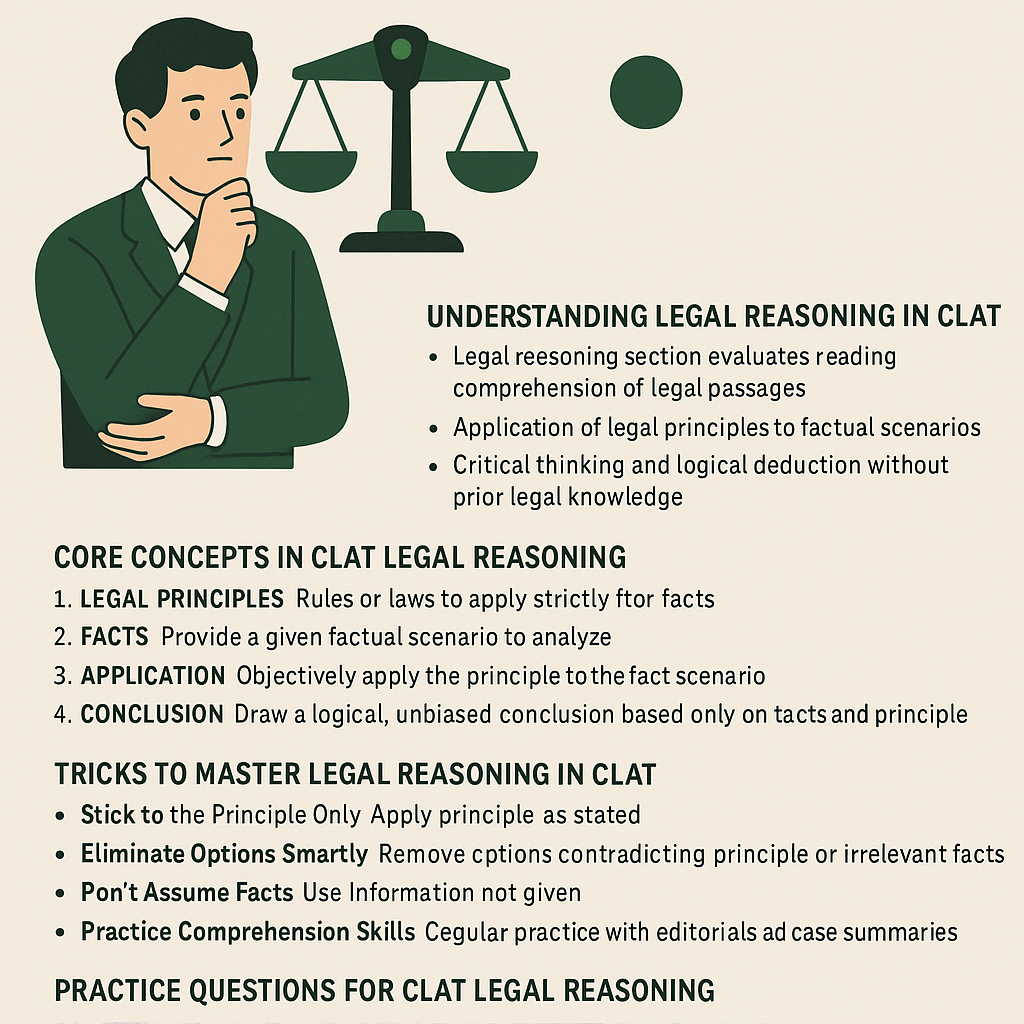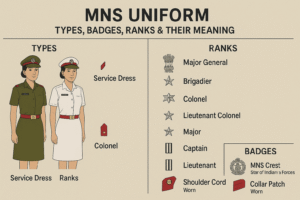Legal Reasoning is the most crucial section in the CLAT (Common Law Admission Test). It tests a candidate’s ability to understand and apply legal principles and reasoning to given fact situations. With approximately 25% weightage in the CLAT exam, mastering Legal Reasoning is essential for securing a top rank.
This comprehensive guide will help you understand key concepts, strategic tricks, and provide sample questions to boost your preparation.
UNDERSTANDING LEGAL REASONING IN CLAT
The Legal Reasoning section primarily evaluates:
Reading Comprehension of legal passages
Application of legal principles to factual scenarios
Critical thinking and logical deduction without prior legal knowledge
Key Features of Legal Reasoning Questions
No prior knowledge of law required
Questions are based on principles explained in the passage
Objective is to check reasoning, not legal accuracy
CORE CONCEPTS IN CLAT LEGAL REASONING
1. Legal Principles
These are rules or laws provided in the passage. You are expected to apply them strictly to the facts.
Example:
“Every person has a right to defend their property.”
You must apply such principles to determine the legality of actions described in the question.
2. Facts
The factual scenario (case) is given to test your interpretation and decision-making skills.
3. Application
Apply the given principle objectively to the fact scenario, avoiding personal bias.
4. Conclusion
You must draw a logical, unbiased conclusion based only on the facts and the legal principle provided.
TRICKS TO MASTER LEGAL REASONING IN CLAT
1. Stick to the Principle Only
Even if the principle contradicts your knowledge or common sense, always apply it as it is stated.
2. Eliminate Options Smartly
Use the elimination technique. Remove options that contradict the principle or introduce new, irrelevant facts.
3. Don’t Assume Facts
Avoid assumptions. Stick strictly to the information given in the question.
4. Practice Comprehension Skills
Legal passages can be long and complex. Regular practice of reading editorials and legal case summaries helps in faster comprehension.
5. Time Management
Aim to complete this section in 30–35 minutes. Prioritize easier questions first to gain momentum.
TYPES OF LEGAL REASONING QUESTIONS IN CLAT
1. Principle-Fact Questions
Most common type. Apply the principle to the facts and choose the correct conclusion.
2. Assertion-Reason Questions
Although less frequent now, sometimes a legal assertion is given followed by a reasoning. You need to judge the relationship between the two.
3. Legal GK Based Questions (Rare)
On rare occasions, general legal knowledge questions may appear, such as landmark cases or constitutional provisions.
PRACTICE QUESTIONS FOR CLAT LEGAL REASONING
Question 1
Principle: Any person who commits theft shall be punished.
Fact: A picks up B’s phone lying unattended on a bench and keeps it.
Answer Options:
A) A has committed theft
B) A has not committed theft
C) A borrowed it
D) No offence is made out
Correct Answer: A – A has committed theft as he dishonestly took someone else’s property without consent.
Question 2
Principle: A person is liable for defamation if they publish a false statement harming the reputation of another.
Fact: X falsely accuses Y of fraud in a newspaper article.
Correct Answer: X is liable for defamation.
Question 3
Principle: Self-defense is allowed if there is an imminent threat.
Fact: Rakesh attacks Mohan with a stick. Mohan pulls out a knife and injures Rakesh.
Correct Answer: Mohan acted in self-defense and is not liable.
BEST SOURCES TO PREPARE LEGAL REASONING FOR CLAT
LegalEdge CLAT Modules
Previous Year CLAT Papers
RS Aggarwal Legal Aptitude (for practice)
Legal Awareness and Legal Reasoning by AP Bhardwaj
Mock Tests and Legal Passages from CLATPrep, CLAT Possible
DAILY STUDY PLAN FOR LEGAL REASONING
| Time Slot | Task |
|---|---|
| 1 Hour | Read legal comprehension passages |
| 30 Minutes | Practice 10–15 principle-fact questions |
| 30 Minutes | Analyze incorrect answers from mocks |
| 20 Minutes | Revise legal maxims and important cases |
FREQUENTLY ASKED QUESTIONS (FAQ)
Q1. Is prior legal knowledge required for CLAT Legal Reasoning?
No. All legal principles are provided in the passage. You just need to read carefully and apply them logically.
Q2. How many questions come from Legal Reasoning in CLAT?
Approximately 28–32 questions (around 25% of the paper).
Q3. How do I improve my speed in this section?
Practice legal comprehension daily, take timed sectional tests, and analyze your mock test errors.
Q4. What’s the best way to deal with confusing options?
Stick strictly to the principle. Eliminate options that go beyond it or include assumptions.
Q5. Can reading newspapers help in legal reasoning?
Yes. Editorials help improve reading speed and comprehension—crucial skills for long legal passages.
CONCLUSION
Legal Reasoning is a game-changer in CLAT. With the right approach, consistent practice, and a strong understanding of how to apply principles objectively, you can excel in this section. Remember, clarity and logic beat memorization here. Make it a daily habit, stay consistent, and you’ll master Legal Reasoning in no time.






